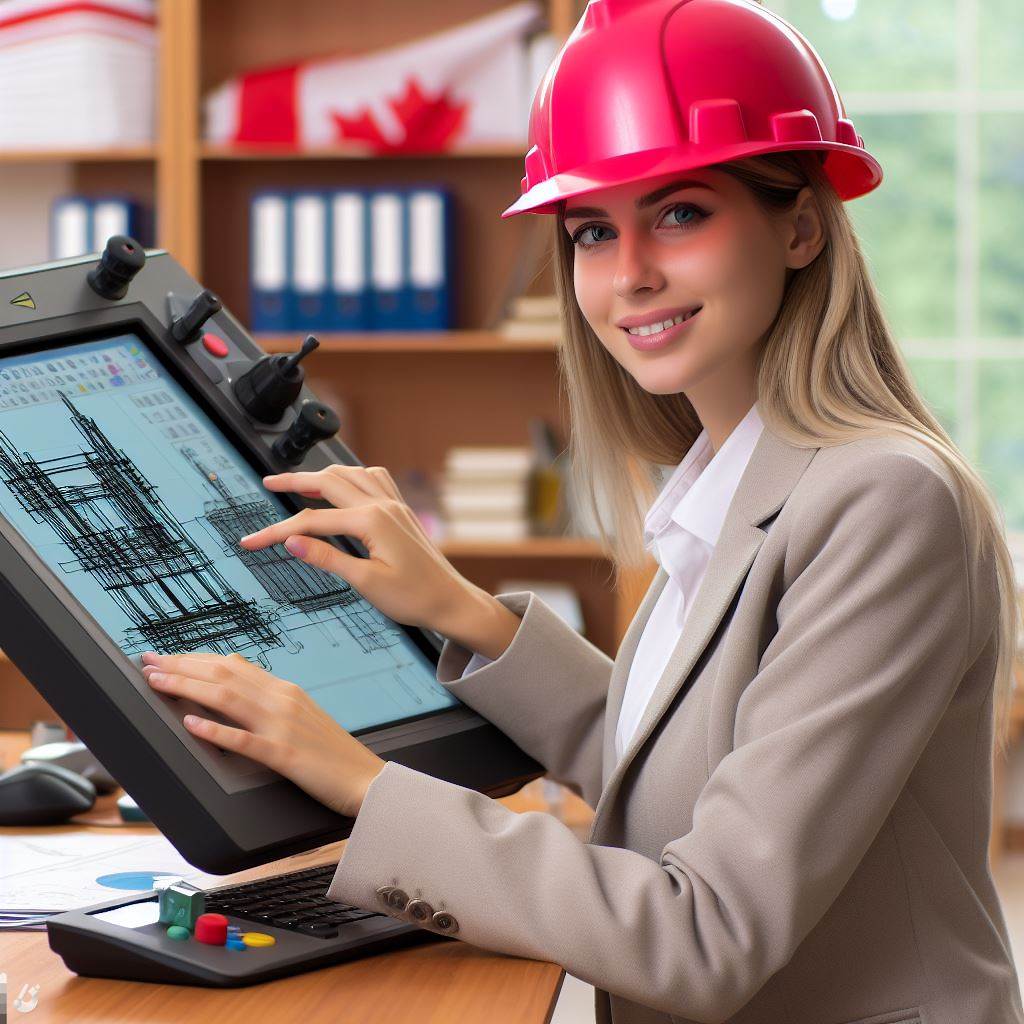Introduction
Let’s explore drafting in Canada.
Drafting plays a crucial role in various industries, providing the foundation for design and construction.
In Canada, drafting forms the backbone of engineering, architecture, and manufacturing sectors.
It involves creating technical drawings, plans, and blueprints that guide the construction process.
Currently, drafting in Canada is undergoing significant transformations due to emerging trends and technological advancements.
The traditional methods of drafting, including manual hand-drawn sketches, have been largely replaced by computer-aided design (CAD) software.
The use of CAD not only improves accuracy but also enhances productivity and efficiency.
It allows drafters to create detailed and precise drawings, make quick modifications, and produce multiple design variations effortlessly.
Moreover, the integration of CAD with other software systems facilitates collaboration among teams, ensuring seamless communication and coordination.
Drafters can easily share their work with architects, engineers, and project managers, enabling real-time feedback and minimizing errors.
Additionally, the advent of 3D modeling and virtual reality (VR) technologies has revolutionized the drafting process.
These technologies provide a realistic visualization of the design, allowing stakeholders to explore the project’s spatial characteristics and identify potential challenges before the construction phase.
Furthermore, the future of drafting in Canada holds even more possibilities with the emergence of emerging technologies such as artificial intelligence (AI) and machine learning.
These technologies are expected to automate repetitive tasks, optimize design processes, and enhance accuracy.
In summary, drafting plays a critical role in various industries in Canada.
The current state of drafting is witnessing a shift towards digitization and the use of advanced technologies like CAD, 3D modeling, and VR.
As the future unfolds, further advancements, including AI integration, will transform the drafting landscape, making it more efficient, precise, and collaborative.
Evolution of Drafting in Canada
Over the years, the field of drafting in Canada has undergone significant changes and advancements.
From traditional methods to the introduction of digital drafting techniques, the industry has embraced new technologies to improve efficiency and productivity.
One of the key drivers of this evolution is the emphasis on Computer-Aided Design (CAD) software and its impact on the drafting profession.
Traditional methods of drafting
- Before the advent of computer technology, drafting in Canada relied on traditional manual techniques.
- Drafters used drawing boards, pencils, and various drafting instruments to create precise technical drawings.
- Hand-drawn lines, measurements, and annotations were time-consuming and required a high level of skill and accuracy.
- Accuracy was crucial as even the smallest error could lead to costly mistakes during construction or manufacturing.
- Despite the labor-intensive nature, traditional drafting methods served the industry well for many years.
Introduction of digital drafting techniques
- The introduction of digital drafting techniques revolutionized the field of drafting in Canada.
- Initially, 2D CAD software allowed drafters to create digital versions of technical drawings.
- These software tools enabled increased accuracy, faster creation, and easier modification of drawings.
- Drafters could now quickly produce multiple copies and share electronic files with collaborators.
- The transition from hand-drawn to digital drafting brought significant time savings and improved productivity.
Emphasis on CAD software and its impact on the industry
- CAD software has become the backbone of the drafting industry in Canada.
- With CAD, drafters can work in both 2D and 3D, allowing for more realistic and comprehensive design representations.
- The software provides precise measurements, automatic dimensioning, and advanced visualization tools.
- Collaboration has also been enhanced as multiple drafters can work on the same project simultaneously.
- CAD software has significantly reduced errors, improved accuracy, and streamlined the drafting process.
- Furthermore, the software enables seamless integration with other design and analysis software, enhancing overall workflow.
In short, drafting in Canada has evolved from traditional manual methods to embracing digital technologies such as CAD software.
The introduction of CAD has revolutionized the industry by improving accuracy, productivity, and collaboration among drafters.
As technology continues to advance, the future of drafting in Canada will likely see further integration of innovative tools and techniques, allowing drafters to create even more sophisticated and precise technical drawings.
Read: Veterinary Technicians in Canada: A Study
Current Trends in Drafting
Increased demand for 3D modeling and virtual reality representation
- The field of drafting in Canada is witnessing an increased demand for 3D modeling.
- Architectural and engineering firms are using 3D modeling to create realistic representations of their designs.
- 3D modeling allows clients to visualize the final product and make informed decisions.
- Virtual reality representation takes 3D modeling to the next level by immersing users in a virtual environment.
- Virtual reality technology gives clients a firsthand experience of the design and helps in identifying potential issues.
- The use of 3D modeling and virtual reality in drafting is expected to continue growing in the future.
Integration of Building Information Modeling (BIM) in drafting
- Building Information Modeling (BIM) is becoming an integral part of the drafting process in Canada.
- BIM allows for the creation of a digital representation of a building, including its physical and functional characteristics.
- It enables architects, engineers, and contractors to collaborate and share information seamlessly.
- BIM helps in detecting clashes and conflicts between various building systems before construction begins.
- The integration of BIM in drafting improves accuracy, reduces errors, and enhances overall project efficiency.
- With the advancement of technology, BIM is evolving and becoming more sophisticated, promising even greater benefits.
Focus on sustainability and green building design
- There is a growing emphasis on sustainability and green building design in the field of drafting.
- Architects and designers are incorporating sustainable practices and materials into their drafts.
- Sustainable design aims to minimize the environmental impact of buildings and promote energy efficiency.
- Drafting now involves considerations such as passive heating and cooling techniques, renewable energy sources, and water conservation.
- Green building certifications, such as LEED, are becoming increasingly popular, driving the adoption of sustainable drafting practices.
- By focusing on sustainability, drafters in Canada are contributing to a greener and more eco-friendly future.
In general, the future of drafting in Canada is characterized by various trends and technological advancements.
Unlock Your Career Potential
Visualize a clear path to success with our tailored Career Consulting service. Personalized insights in just 1-3 days.
Get StartedThe increased demand for 3D modeling and virtual reality representation is revolutionizing the way designs are visualized and communicated.
The integration of Building Information Modeling (BIM) in the drafting process allows for seamless collaboration and improved project efficiency.
Furthermore, the focus on sustainability and green building design is transforming the drafting industry towards a more environmentally conscious approach.
As technology continues to advance, drafting in Canada will continue to evolve, offering exciting opportunities for drafters to enhance their skills and contribute to innovative and sustainable designs.
Read: Tech Technician vs. Medical Technician
Technological Advancements in Drafting
The future of drafting in Canada is being shaped by various technological advancements that are revolutionizing the field.
These advancements include:
Introduction of AI-powered drafting tools
AI-powered drafting tools are becoming increasingly popular in the industry, offering advanced capabilities and streamlining the drafting process.
These tools can analyze data, generate designs, and provide valuable insights.
They greatly enhance the productivity and efficiency of drafting professionals.
Utilization of automation and machine learning in drafting processes
Automation and machine learning techniques are being integrated into drafting processes to reduce manual effort and minimize errors.
Drafting software can now automatically generate blueprints, perform calculations, and ensure compliance with building codes.
It allows drafters to focus on more complex tasks, improving accuracy and saving time.
Development of cloud-based collaboration platforms for drafting professionals
Cloud-based collaboration platforms are changing the way drafting professionals work together.
These platforms enable real-time collaboration, allowing multiple drafters to work on the same project simultaneously.
They enhance communication, facilitate file sharing, and improve coordination among team members.
Drafting professionals can now easily collaborate with colleagues and clients from anywhere, increasing flexibility and efficiency.
Basically, technological advancements in drafting are reshaping the future of the profession in Canada.
The introduction of AI-powered drafting tools, the utilization of automation and machine learning, and the development of cloud-based collaboration platforms are revolutionizing the way drafters work.
These advancements offer enhanced productivity, improved accuracy, and increased flexibility, benefiting both drafting professionals and their clients.

Impacts on Drafting Professionals
Changes in Required Skill Set for Drafters
- Technological Evolution: Rapid advancements necessitate a shift from traditional skills to proficiency in cutting-edge technologies.
- Embrace of CAD Software: Mastery of computer-aided design (CAD) software becomes paramount, replacing manual drafting skills.
- Multifaceted Competencies: Drafters require diverse skills, adapting to evolving software, tools, and methodologies for comprehensive expertise.
Potential Job Growth or Displacement Due to Technological Advancements
- Automation Dynamics: Automation and machine learning streamline processes, posing both potential job growth and displacement.
- Obsolescence Risks: Certain manual roles face obsolescence as technology optimizes efficiency, reshaping the employment landscape.
- Emergence of New Roles: Managing and operating advanced drafting technologies creates avenues for novel job opportunities.
Importance of Continuous Learning and Adaptation
- Dynamic Learning Curve: Continuous learning is imperative in a dynamic industry where technological shifts define professional landscapes.
- Swift Adaptation: Drafting professionals must swiftly adapt to evolving tools, software, and methodologies for sustained relevance.
- Competitive Edge: Staying competitive demands alignment with industry trends and expertise in state-of-the-art tools and software.
- Learning Avenues: Varied channels, from workshops to online courses, facilitate ongoing skill enhancement crucial for professional growth.
- Soft Skills Imperative: Beyond technical prowess, soft skills like critical thinking and effective communication are indispensable for collaboration.
- Collaboration Proficiency: Effective engagement with architects, engineers, and stakeholders demands polished communication and teamwork skills.
Therefore, the future of drafting in Canada hinges on dynamic trends and technological advances.
Drafting professionals face a transformative landscape, demanding a paradigm shift in skill sets.
The industry’s trajectory toward automation and innovation brings forth challenges and opportunities.
The importance of continuous learning and adaptation cannot be overstated, as professionals navigate a future defined by technological prowess and the need for multifaceted competencies.
Embracing change and remaining attuned to industry trends will be instrumental in ensuring the success and relevance of drafting professionals in Canada’s evolving landscape.
Read: Technician Job Growth in Canada: Analysis
Future Outlook & Opportunities
How new technologies will shape the drafting industry
- Introduction of 3D printing will revolutionize the way drafters create prototypes.
- Virtual reality (VR) and augmented reality (AR) will enhance drafting processes and improve collaboration.
- Artificial intelligence (AI) will automate repetitive tasks, increasing productivity and reducing errors.
- Cloud-based systems will enable real-time collaboration and access to files from anywhere.
- Internet of Things (IoT) will create new opportunities for drafters to integrate smart devices into designs.
Potential advancements in drafting tools and software
- Advanced CAD software will offer more intuitive interfaces and powerful modeling capabilities.
- Integration of AI algorithms in drafting software will automate design optimization and suggest improvements.
- New drafting tools will be developed specifically for virtual reality environments, enhancing design visualization.
- Simulations and analysis tools will provide real-time feedback on structural integrity and energy efficiency.
- Advanced rendering engines will provide photorealistic visualizations of designs, aiding in marketing presentations.
Emerging job roles and opportunities for drafting professionals
The future of drafting in Canada holds exciting prospects:
- BIM specialists manage complex construction projects with high demand.
- Drafters with 3D printing expertise anticipate thrilling career prospects.
- VR/AR specialists create immersive design experiences and virtual walkthroughs.
- Data analysts with drafting software knowledge analyze data for informed decision-making.
- Drafting professionals with sustainable design skills play a crucial role in addressing environmental challenges.
Rapid tech progress promises a bright future
- 3D printing efficiently creates cost-effective physical prototypes for faster iterations and improved development processes.
- VR/AR enhances drafting processes, allowing immersive visualization and on-site collaboration.
- Artificial intelligence automates repetitive tasks, saving time and allowing focus on creative aspects.
- Cloud-based systems revolutionize collaboration, enabling real-time file access and streamlined workflows.
- Internet of Things integrates smart devices, providing real-time data for predictive maintenance and enhanced efficiency.
- Drafting tools and software advancements drive innovation, offering intuitive interfaces and advanced modeling capabilities.
- Tools designed for virtual reality environments provide immersive experiences for walking through and modifying designs.
- Simulations and analysis tools offer real-time feedback, aiding informed decisions and design optimization.
- Advanced rendering engines provide photorealistic visualizations, enhancing marketing presentations and client communication.
Emerging job roles and opportunities
- BIM specialists manage complex projects using Building Information Modeling techniques.
- 3D printing and additive manufacturing experts find exciting prospects across various industries.
- VR/AR specialists create realistic design experiences and virtual walkthroughs for clients.
- Data analysts skilled in drafting software optimize designs and identify improvements.
- Drafting professionals with sustainable design skills are essential in addressing environmental challenges.
In essence, Canada’s drafting future is full of opportunities. Embracing changes is crucial for professionals to thrive in this technology-driven landscape.
Read: Remote Work for Technicians: A Reality?
Conclusion
Throughout history, drafting in Canada has undergone significant changes, adapting to emerging technologies and evolving industries.
From manual drawing tools to computer-aided design (CAD) software, the field has embraced technological advancements.
Looking ahead, the future of drafting appears promising, as technology continues to advance at an unprecedented pace.
Automation, artificial intelligence (AI), and machine learning will play crucial roles in streamlining drafting processes, improving accuracy, and increasing productivity.
Moreover, drafting will remain a vital component in various industries, including architecture, engineering, manufacturing, and construction.
The ability to visualize and communicate complex ideas through technical drawings will continue to be essential for these sectors.
As the demand for sustainable and environmentally-friendly practices increases, drafting will also play a significant role in creating sustainable designs.
Energy-efficient buildings, renewable energy systems, and eco-friendly infrastructure projects will require skilled drafters to transform concepts into feasible plans.
Furthermore, the integration of virtual reality (VR) and augmented reality (AR) in drafting will revolutionize the design and review processes.
Architects and engineers can immerse themselves in virtual environments, making real-time modifications and ensuring design accuracy before construction begins.
In closing, the future of drafting in Canada is a dynamic and exciting landscape.
By embracing technological advancements, drafters will further enhance their skills and capabilities, contributing to the growth and success of various industries.
With continued innovation, drafting will remain a fundamental aspect of transforming ideas into tangible plans and structures that shape our world.




